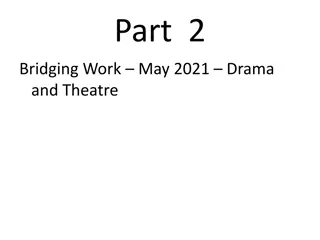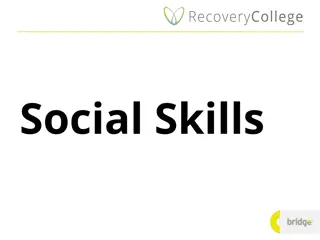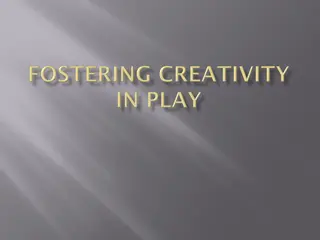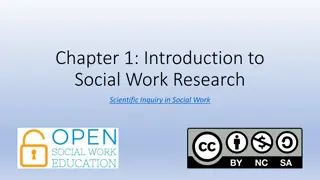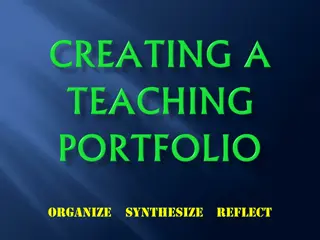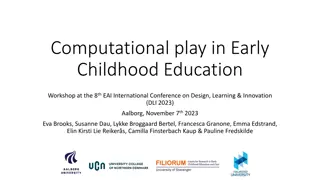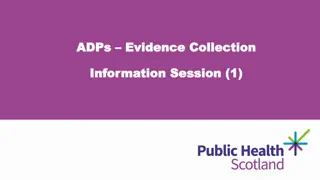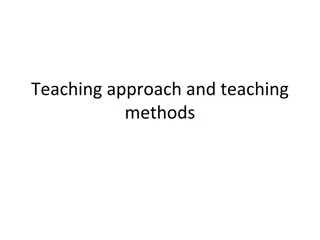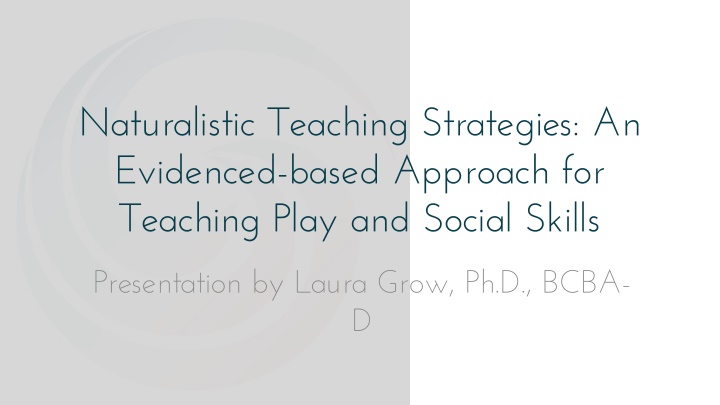
Naturalistic Teaching Strategies: An Evidence-Based Approach for Play and Social Skills
This presentation by Laura Grow, Ph.D., BCBA-D, explores Naturalistic Teaching Strategies (NaTS) as an umbrella term for teaching skills in loosely structured settings by parents, siblings, peers, and teachers. NaTS are used to teach play, social, language, and communication skills, with examples of strategies and components highlighted. Motivation-enhancing techniques are discussed for enhancing generalization of skills in a practical and evidence-based manner.
Download Presentation

Please find below an Image/Link to download the presentation.
The content on the website is provided AS IS for your information and personal use only. It may not be sold, licensed, or shared on other websites without obtaining consent from the author. If you encounter any issues during the download, it is possible that the publisher has removed the file from their server.
You are allowed to download the files provided on this website for personal or commercial use, subject to the condition that they are used lawfully. All files are the property of their respective owners.
The content on the website is provided AS IS for your information and personal use only. It may not be sold, licensed, or shared on other websites without obtaining consent from the author.
E N D
Presentation Transcript
Naturalistic Teaching Strategies: An Evidenced-based Approach for Teaching Play and Social Skills Presentation by Laura Grow, Ph.D., BCBA- D
What are Naturalistic Teaching Strategies (NaTS)? Umbrella term for a set of strategies that share features Skills are taught in loosely structured settings Skills are taught by parents, siblings, peers, and teachers
What are NaTS? NaTS are used to teach Play skills Social skills Language and communication skills
Examples of NaTS Strategies Natural language paradigm/pivotal response training Mand model Incidental teaching/multiple incidental teaching
NaTS Examples https://www.youtube.com/watch?v=mnkEZaA HGrA
Basic Components of NaTS Initiation of learning opportunity by the child Use of motivation-enhancing techniques Enhance generalization of skills
Motivation-enhancing Techniques Use effective reinforcers Vary tasks during teaching Provide choices
Motivation-enhancing Techniques Use effective reinforcers Use effective reinforcers Vary tasks during teaching Provide choices
Motivation-enhancing Techniques 1. Use effective reinforcers a. a. Conduct a preference assessment Conduct a preference assessment b. Provide better reinforcers for better responses c. Restrict access to activities/toys temporarily after extended interaction
Preference Assessments Approach-based assessments Single-stimulus assessment (Pace et al., 1985) Multiple stimulus with/without replacement (DeLeon & Iwata, 1996) Paired-choice assessment (Fisher et al., 1992) Duration-based assessments Single stimulus engagement procedure (Hagopian, Rush, Lewin, & Long, 2001) Free-operant assessment (Roane et al., 1998)
Selecting a Preference Assessment Karsten, Carr, & Lepper (2011) Developed a practitioner model for selecting comprehensive preference assessments Included a decision-making tree to assist with selecting appropriate assessments and addressing issues that might arise
Motivation-enhancing Techniques 1. Use effective reinforcers a. Conduct a preference assessment b. b. Provide better reinforcers for better responses Provide better reinforcers for better responses c. Restrict access to activities/toys temporarily after extended interaction
Provide Better Reinforcers for Better Responses Old Responses Old Responses New/Better Responses New/Better Responses Unprompted responses More praise/more access More praise/more access Prompted responses Less praise/less access More praise/more access
Motivation-enhancing Techniques 1. Use effective reinforcers a. Conduct a preference assessment b. Provide better reinforcers for better responses c. c. Restrict access to activities/toys temporarily after Restrict access to activities/toys temporarily after extended interaction extended interaction
Motivation-enhancing Techniques 1. Use effective reinforcers 2. Vary tasks during teaching a. Avoid massed trials b. Mix new tasks with mastered tasks 3. 3. Provide choices Provide choices
How to Provide Choices Present a selection of toys or activities Wait several seconds If the child selects, restrict access to the selection and remove the other materials If the child doesn t select, replace one or more of the toys and offer another selection If selection is not made, you select the toy/activity***
Generalization-enhancing Strategies Use commercially available materials Teach multiple examples Teach across settings and people Use natural reinforcers
Generalization-enhancing Strategies Use commercially available materials More likely to experience in natural environment More cost effective Teach multiple examples Teach with several sets of materials
Generalization-enhancing Strategies Teach across settings and people Include parents, siblings, and other relevant people Arrange teaching to be similar to natural environment Teach in home and community settings
Generalization-enhancing Strategies Use natural reinforcers Use reinforcers found in natural environment Use intermittent reinforcers*** Teach toleration of delays to reinforcement***
Natural Language Paradigm What is Natural Language Paradigm? What are the basic steps in NLP? Provide choices Deliver prompts Deliver consequences
Why use NLP? Use of multiple high-preference activities may increase compliance / decrease client problem behavior (Mason et al., 1989) Multiple skills can be taught Play skills Language skills Procedure can be used across many places, people, materials, and times of day
How does NLP look? Critical features of NLP include: Frequent choice of materials Frequent exchange of materials ( My turn ) Multiple play targets across trials Reinforcement of approximations Problem behavior blocked / ignored
What Does NLP Look Like? Step 1: Give client a choice Step 2: Show item Pause Provide models Step 3: Client imitates Praise + Toy OR No response Prompt up to 3x Step 4: Repeat model 2x and praise imitation Step 5: My turn Step 6: Offer a new choice
Providing Choices During NLP Present 2 to 3 items in an array (may use Pick one ) Wait 5 sec If an item is selected, remove extra toys as you restrict access to the chosen toy If selection is not made, replace one or more toy(s) and present a 2nd choice If selection is not made, you select the toy/food for the next trial
Presenting Prompts During NLP Two kinds of prompts: Play models for prompting toy interaction (with tangible only) Vocal models for prompting language*** REMEMBER: Present a new choice after a trial with no response after three prompts
Presenting Prompts During NLP Play models Occur at the beginning of every trial and with vocal models, as applicable Include demonstrating use of the toy Imitation of play models should be praised during the child s turn
Presenting Prompts During NLP Vocal models Occur every 5 sec without a response, every trial Include phrases, naming or describing the item or its actions Change the vocal model every other trial with a single item
Presenting Prompts during NLP Examples of vocal and play models for teaching with a truck Truck Roll it Yellow Move the parts Truck rolls Roll it This truck is fast Roll it fast See the big truck Roll it It s a dump truck Make it dump
Presenting Prompts During NLP Examples of vocal and play models for teaching with a bear Bear Make it sit Hug Hug it Soft bear Pet it Brown bear Make it sit Jumping bear Make it jump Give bear a hug Hug it Bear waves Make it wave Bear sleeps Make it lay down
Consequences During NLP Reinforce vocal approximations and appropriate play Block and ignore problem behavior
When to Deliver Consequences After prompted vocal responses that match or are better than previous responses After independent responses that match or are better than previous responses After instances of appropriate play
Putting It All Together Provide Provide access to ball access to ball Model at Model at least 2x least 2x during play during play My turn My turn Child responds (15 sec) (15 sec) Ball Ball Restrict Restrict Access Access Show item Show item for 3 for 3- -5 sec Car Car 5 sec Lion Lion Doll Doll Provide Provide model model Repeat Repeat model up model up to 3x to 3x Child DOES NOT respond Boat Boat Balloon Balloon
Activity Time! Consider a child you work with/know Review the NaTS strategies and develop ideas for programming Select a play skill/language skills appropriate for the child Choose 1 to 3 options for each strategy
Activity Time! Choose three toys/activities Select appropriate play skills and language samples for each toy/activity Select different scenarios to teach the child Identify natural reinforcers
Activity Time! Choose three toys/activities
Activity Time! Select appropriate play skills and language samples for each toy/activity
Activity Time! Select different scenarios to teach the child In what environments can you teach? Who could teach the skills? In what contexts could you teach?
Activity Time! Identify natural reinforcers What types of consequences are delivered in typical settings?
Resources Association for Science in Autism Treatment https://asatonline.org/for-parents/ https://asatonline.org/for-parents/learn-more-about- specific-treatments/
Resources Natural language paradigm https://asatonline.org/for-parents/learn-more-about-specific- treatments/applied-behavior-analysis-aba/aba-techniques/pivotal- response-trainingtreatment-prt-natural-language-paradigm-nlp/ Incidental teaching https://asatonline.org/for-parents/learn-more-about-specific- treatments/applied-behavior-analysis-aba/aba-techniques/incidental- teaching/ Preference assessments https://wmuace.com/videos/stimulus-preference https://www.youtube.com/watch?v=FfYYTh-bt48



